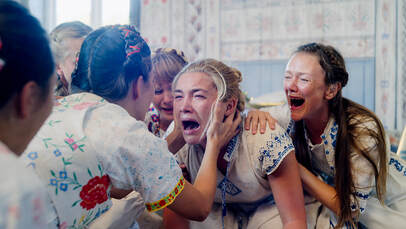 There are horror films, and then there are the near-traumatic experiences which director Ari Aster has now put on screen twice. With Midsommar, Aster has officially established himself as a new master of the genre for years to come… …It wasn’t long ago that Aster brought the familial nightmare, Hereditary, to theaters and introduced audiences to a new voice in terror. But while Hereditary was a more traditional though intelligent haunted house film, Midsommar is something else entirely that is unlike anything else I’ve seen. Written/directed by Aster, Midsommar tells the tragic story of Dani (Florence Pugh), a young woman who has recently lost her family. Feeling like he has to, asshole boyfriend Christian (Jack Reynor) invites Dani to come with him and his friends to Sweden for a thesis project studying the culture of good friend Pelle’s (Vilhelm Blomgren) hometown. It isn’t long before Dani and the others realize that the mid-summer festival they’ve been invited to is far more violent and frightening than the idyllic retreat they were expecting. Aster proved with Hereditary that he is a director who understands grief, and Midsommar is no exception. The loss of Dani’s family haunts her in an utterly devastating performance from Pugh. Aster sets the audience up for what will no doubt be a story that is filled with dread and despair, as we open with Dani desperately trying to find out why her family won’t answer her calls. Grief-stricken, the sounds of Dani’s anguish persist throughout. Her screams and cries blend into a deeply unnerving score from The Haxan Cloak. Midsommar is a deeply personal experience, and is pure, uncomfortable cinema. More than anything, Midsommar is a film about life and death and the trauma of it all, and I lost count of how many times Pugh shattered my heart to pieces with her tears. Making Dani’s agony even harder to watch are the men in her life, particularly, Christian. The relationship they share is the sort of seemingly harmless abuse that so many of us have faced with lovers at one point or another in our lives. Christian is the sort of guy who hugs a distraught Dani while looking over shoulder at another pretty girl in the room. He lies. He forgets things like her birthday. And worst of all, he makes her feel as if her emotions are exaggerated, and as if it’s her fault that things are rough between them because she’s upset. Outside of the painfully charming Pelle, the other guys aren’t much better, with both Josh (William Jackson Harper) and Mark (Will Poulter) caring less about her feelings and more about how Dani unexpectedly intruding on their trip is going to affect their time. Needless to say, I frequently wanted to shout obscenities at the screen during Midsommar. And this is where the true brilliance of Aster really comes in. Despite all of the grief, anger, and tragedy, Aster takes a bold approach with Midsommar by shooting near a hundred percent of the film in pure, bright, blissful daylight. Any horror director can find ways to scare you in the dark, but Aster successfully gets under the skin without eerie shadows or creaking branches in a dark forest. The horror of Midsommar hides in plain daylight, through the strange smiles of the white-robed townspeople, the ominous, incredible production design depicting triangular yellow churches and disturbing paintings, or the casual sacrifice or two right in front of Dani and friends to set the mood for things to come. Keep in mind, Midsommar is not what modern audiences might consider “scary”. Nothing is going to jump out at you. Characters are not stalked through a creepy house. What Midsommar is, is relentless dread which creeps from the bottom of your spine until the final, shocking moments. A lot of that dread can be attributed to the unforgettable imagery in Midsommar. There are moments that are so awful yet so beautifully shot by cinematographer Pawel Pogorzelski, that they’re breathtaking. Watching Midsommar is like watching a tornado rip through a home. The image is horrible, but it’s also so powerful, you can’t look away. Like Hereditary, there’s a lot going on with the imagery of Midsommar. To say it’s breathtaking can also be taken literally, as there’s a good portion of the film where the images themselves do breathe. Our characters often find themselves on some kind of drug or another, causing the scene around them to pulse and shimmer like waves. It’s a hypnotic, trippy effect that speaks to Aster’s visionary talents, and Midsommar is a vision unlike any other. It also plays into a major theme of life and nature in the film, as the pagan cultists make heavy breathing a part of their rituals, as does Dani whenever she is trying to cope with her sadness. Some will say Midsommar runs too long, and at just over 140 minutes, that’s fair. Admittedly, there are a few points towards the end where the film experiences a bit of a lull, and certain moments arguably take more time than necessary to play out, so there will no doubt be frustration with some audience members. But what Aster is doing here is pulling us deep into the world of this cult. The length of the film allows us to explore every inch of the town and every aspect of the ritualistic horror which they believe so strongly in. Midsommar introduces us to a well-thought out world full of foreshadowing drawings and dialogue that gives the film immediate rewatch value. There’s a lot to unpack here, and I was ready to stroll right back into the theater so I could learn more. Ari Aster is on another level with this film. Midsommar will no doubt turn some viewers off with its awkward, naked rituals and gut-wrenching horror, but I found it to be a thoughtful nightmare that is damn near perfection worthy of a celebratory “Skal!” Midsommar is now sacrificing audiences in theaters. By Matt Konopka
0 Comments
Leave a Reply. |
Archives
March 2023
|


 RSS Feed
RSS Feed